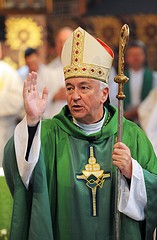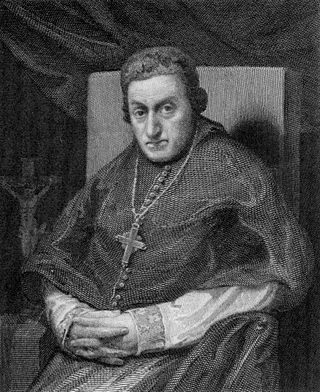
The Archbishop of Westminster heads the Roman Catholic Diocese of Westminster, in England. The incumbent is the metropolitan of the Province of Westminster, chief metropolitan of England and Wales and, as a matter of custom, is elected president of the Catholic Bishops' Conference of England and Wales, and therefore de facto spokesman of the Catholic Church in England and Wales. All previous archbishops of Westminster have become cardinals. Although all the bishops of the restored diocesan episcopacy took new titles, like that of Westminster, they saw themselves in continuity with the pre-Reformation Church and post-Reformation vicars apostolic and titular bishops. Westminster, in particular, saw itself as the continuity of Canterbury, hence the similarity of the coats of arms of the two sees, with Westminster believing it has more right to it since it features the pallium, a distinctly Catholic symbol of communion with the Holy See.

Charles Butler KC was an English Roman Catholic lawyer and miscellaneous writer.
Cisalpinism was a movement among English Roman Catholics in the late eighteenth century intended to further the cause of Catholic emancipation, i.e. relief from many of the restrictions still in effect that were placed on Roman Catholic British subjects. This view held that allegiance to the Crown was not incompatible with allegiance to the Pope.
The Nonjuring schism refers to a split in the established churches of England, Scotland and Ireland, following the deposition and exile of James II and VII in the 1688 Glorious Revolution. As a condition of office, clergy were required to swear allegiance to the ruling monarch; for various reasons, some refused to take the oath to his successors William III and II and Mary II. These individuals were referred to as Non-juring, from the Latin verb iūrō, or jūrō, meaning "to swear an oath".

Charles Walmesley, OSB was the Roman Catholic Titular Bishop of Rama and Vicar Apostolic of the Western District of England. He was known, especially in Ireland, for predicting the downfall of Protestantism in 1821–5 and the triumphant emergence of the Catholic Church.

The Diocese of Westminster is a Latin archdiocese of the Catholic Church in England. The diocese consists of most of London north of the River Thames and west of the River Lea, the borough of Spelthorne, and the county of Hertfordshire, which lies immediately to London's north.

The Archdiocese of Birmingham is one of the principal Latin Church diocese of the Catholic Church in England and Wales. The archdiocese covers an area of 3,373 square miles (8,740 km2), encompassing Staffordshire, the West Midlands, Warwickshire, Worcestershire and much of Oxfordshire as well as Caversham in Berkshire. The metropolitan see is in the City of Birmingham at the Metropolitan Cathedral Church of Saint Chad. The metropolitan province includes the suffragan dioceses of Clifton and Shrewsbury.
Joseph Berington was a priest and one of the prominent British Catholic writers of his day.
In Ireland, the penal laws were a series of legal disabilities imposed in the seventeenth, and early eighteenth, centuries on the kingdom's Roman Catholic majority and, to a lesser degree, on Protestant "Dissenters". Enacted by the Irish Parliament, they secured the Protestant Ascendancy by further concentrating property and public office in the hands of those who, as communicants of the established Church of Ireland, subscribed to the Oath of Supremacy. The Oath acknowledged the British monarch as the "supreme governor" of matters both spiritual and temporal, and abjured "all foreign jurisdictions [and] powers"—by implication both the Pope in Rome and the Stuart "Pretender" in the court of the King of France.
William Poynter was an English Catholic priest, bishop as vicar apostolic in London.

The Roman Catholic Relief Act 1791 is an Act of the Parliament of Great Britain passed in 1791 relieving Roman Catholics of certain political, educational, and economic disabilities. It admitted Catholics to the practice of law, permitted the exercise of their religion, and the existence of their schools. On the other hand, chapels, schools, officiating priests and teachers were to be registered, assemblies with locked doors, as well as steeples and bells to chapels, were forbidden; priests were not to wear vestments or celebrate liturgies in the open air; children of Protestants were not to be admitted to the schools; monastic orders and endowments of schools and colleges were prohibited.
The English Protestant Reformation was imposed by the English Crown, and submission to its essential points was exacted by the State with post-Reformation oaths. With some solemnity, by oath, test, or formal declaration, English churchmen and others were required to assent to the religious changes, starting in the sixteenth century and continuing for more than 250 years.
John Milner was an English Roman Catholic bishop and controversialist who served as the Vicar Apostolic of the Midland District from 1803 to 1826.
A royal veto of the appointment of bishops was proposed in the United Kingdom of Great Britain and Ireland from 1808 to 1829 during the move towards Catholic Emancipation.
The Roman Catholic Relief Bills were a series of measures introduced over time in the late eighteenth and early nineteenth centuries before the Parliaments of Great Britain and the United Kingdom to remove the restrictions and prohibitions imposed on British and Irish Catholics during the English Reformation. These restrictions had been introduced to enforce the separation of the English church from the Catholic Church which began in 1529 under Henry VIII.
Charles Berington was an English Roman Catholic bishop who served as the Vicar Apostolic of the Midland District from 1795 to 1798.

George Hay was a Scottish Catholic prelate and writer who served as Vicar Apostolic of the Lowland District from 1778 to 1805.
John Douglass was an English Roman Catholic bishop who was the Vicar Apostolic of the London District from 1790 until his death in 1812.
John Kirk D.D. (1760–1851) was an English Roman Catholic priest and antiquary.
Gregory Stapleton D.D. was an English Roman Catholic bishop. While president of St. Omer's English College, he and his students were imprisoned during the French Revolution.






